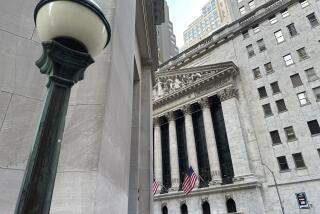Bonds Suggest Only Modest Gains in Jobs
- Share via
Heading into Friday’s key report on August employment trends, the Treasury bond market on Monday sent a signal that it expected job gains to remain muted at best: Long-term bond yields slipped to their lowest levels since April.
Some analysts say investors who are willing to lock in long-term Treasury yields at these levels are underestimating the economy’s growth potential -- and underestimating how high interest rates could go during the next year.
“Behind the scenes the economy still is looking like it’s doing quite well,” said Joseph Carson, economist at Alliance Capital Management in New York.
Yet on Monday, the yield on the 30-year Treasury bond fell below 5% for the first time since early in April, ending at 4.98%, down from 5.02% on Friday.
The 10-year T-note yield, a benchmark for mortgages, closed at 4.18%, down from 4.23% on Friday and the lowest since the first week of April.
Falling bond yields often indicate that investors believe economic growth will decelerate, keeping inflation subdued as well.
But the trend is more good news for the housing market because it could put downward pressure on mortgage rates, which have averaged under 6% for the last four weeks.
Trading in all markets Monday was limited because of Wall Street’s vacation-thinned ranks. Even so, the latest drop in yields suggests little concern in the bond market that the August employment report, due Friday, could be surprisingly strong.
Most economists estimate that a net 100,000 to 200,000 jobs were created in August.
The average estimate for July had been 230,000 jobs. When the government reported on Aug. 6 that the nation posted a net gain of just 32,000 jobs in July, bond yields plunged, and they have stayed down since.
The economic news on Monday encouraged bond buyers. Consumer spending rebounded in July after declining in June, the Commerce Department said. However, personal income rose at the slowest pace since November 2002 -- raising questions about consumers’ ability to continue spending at a brisk rate.
The bond market also took comfort in the latest reading of an inflation index that is closely watched by Federal Reserve Chairman Alan Greenspan: The core personal consumption expenditures price index, a measure of the prices of consumer goods excluding food and energy, was unchanged in July from June and was up a tame 1.5% from a year earlier.
If inflation stays relatively low, analysts say, the Fed could feel less pressure to continue raising short-term interest rates over the next year -- particularly if economic growth is slower than expected.
The inflation report “is great news for the Fed,” said Sean Flannery, fixed-income strategist at State Street Global Advisors in Boston. “It gives them some leeway” in adjusting rates.
For now, though, most economists believe the Fed is on track to raise its key short-term rate, the federal funds rate, another quarter-point when policymakers meet Sept. 21.
The Fed on June 30 tightened credit for the first time in nearly four years when it raised its key rate from 1% to 1.25%. It followed that with another increase, to 1.5%, on Aug. 10, despite the anemic July jobs report.
The trend in other short-term interest rates indicates the financial markets are almost sure of another increase at next month’s Fed meeting. For example, the yield on the three-month Treasury bill rose to 1.57% on Monday from 1.55% on Friday and now is the highest since October 2002.
Given expectations for further increases in short-term rates, and the potential for the economy to strengthen if oil prices continue to slide, some analysts question why investors are willing to lock in long-term bond yields at current levels.
“The bond market is doing the same thing today that it did at the end of the first quarter,” said Alliance’s Carson. Long-term Treasury yields slumped in March as many investors began to lose faith in the economy.
When the government on April 2 reported a surge in job creation in March, however, bond yields rocketed. The 10-year T-note yield soared from 3.84% at the end of March to 4.51% by the end of April.
Carson said long-term bond buyers might be wrong, once again, in underestimating the economy. He thinks that the 10-year T-note will peak above 5% next year if the expansion stays on track.
Some experts are watching another interest rate gauge for clues about the economy: yields on corporate junk bonds, those issued by companies considered to be high risks.
The average yield on an index of 100 junk bonds tracked by KDP Investment Advisors was 7.26% on Monday, near the lowest level since May and down from 7.6% early in August. In theory, if the economy were weakening, investors would shun junk bonds because of the potential that more junk issuers could have trouble paying their bills.
Junk bonds “have been impervious to bad news” about the economy in recent months, said Margaret Patel, a corporate bond fund manager at Pioneer Investments in Boston. That suggests junk-bond investors believe that business activity hit a temporary soft spot in summer and will turn up this fall.
Patel is in that camp: “I do think the economy will do a lot better.”
Others, however, say that the economy still may be losing momentum and that buyers of Treasury bonds at these levels are tapping into that theme.
“There’s not a lot to make us believe there’s anything particularly robust happening” in the economy, Flannery said. The talk in the bond market, he said, is that the 10-year T-note yield could quickly fall below 4% on Friday or next week, if the August employment numbers are weaker than expected.
The risk also is substantial on the other side, say analysts who are more bullish on the economy. Year to date, long-term bond mutual funds generally are boasting positive returns, but “we could lose that return in a day” if yields soar on an upbeat employment report Friday, devaluing older bonds, said James Bianco, head of bond research firm Bianco Research in Chicago.
More to Read
Inside the business of entertainment
The Wide Shot brings you news, analysis and insights on everything from streaming wars to production — and what it all means for the future.
You may occasionally receive promotional content from the Los Angeles Times.










